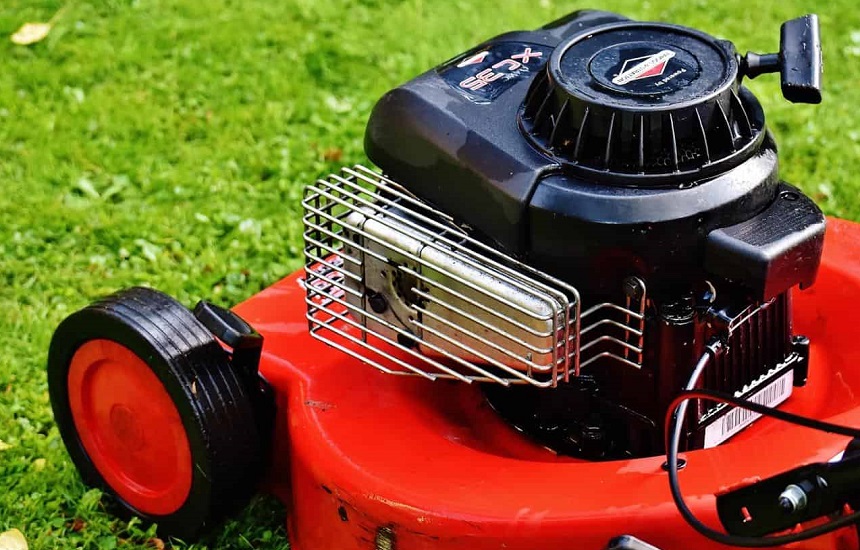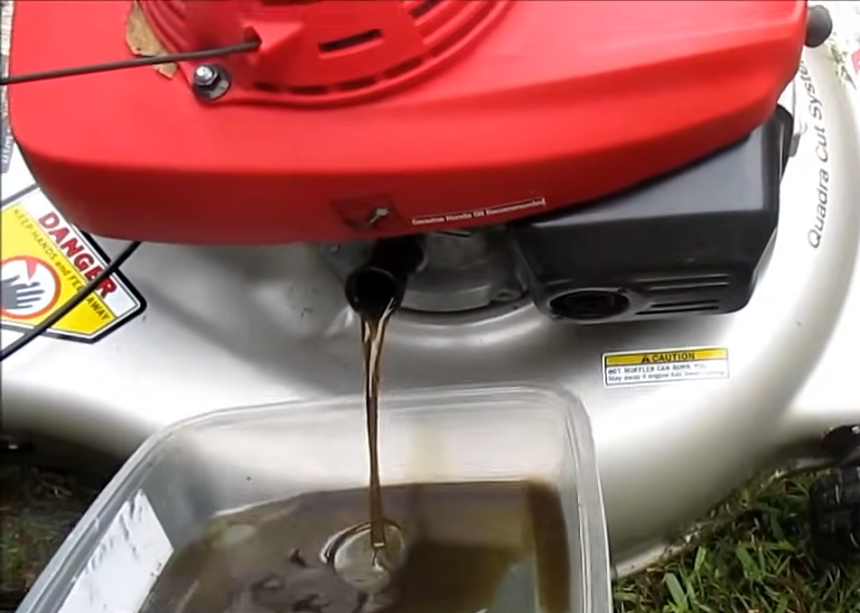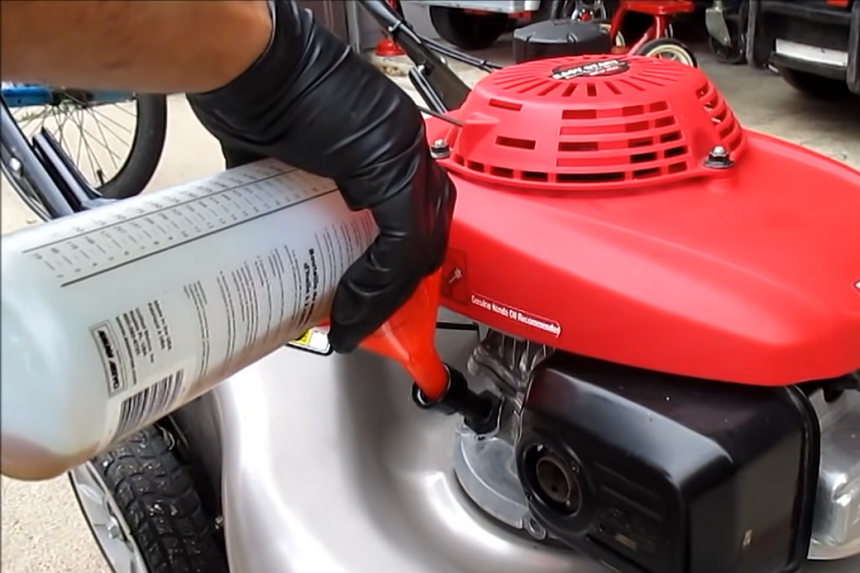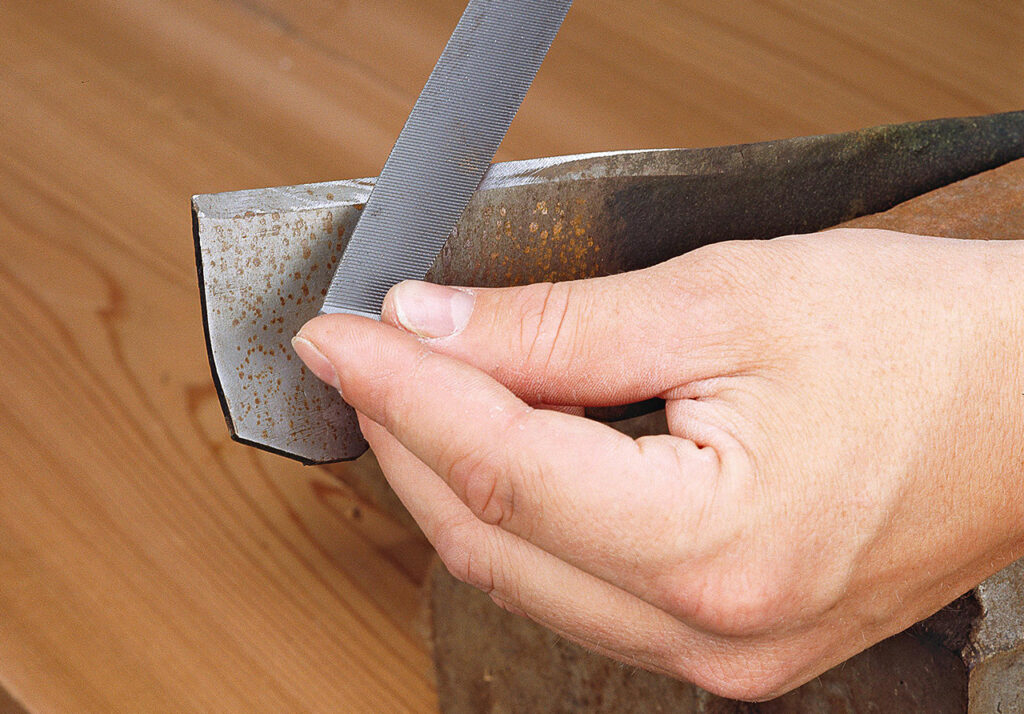Technology has blessed us with tools and machines that have made things much easier than they used to be. Grasses grow – they have always been growing but instead of going under the hot sun to cut these stubborn grasses, lawnmowers make it possible to lawn a field in minutes without breaking a sweat.
It is also quite understandable as to how you’d want to invest in purchasing the best lawnmower for yourself and your needs. But as you do so, it is also best to purchase the best engine oil and also learn how to change the oil in a lawnmower. Here’s why. No matter how great your mower is, it will always break down from wear and tear or too much friction (all machines do).
Therefore, at that point, you would need to lubricate all the movable parts and also add more oil to the engine drum. Lack of this would result in a short lifespan of your lawnmower. So without any further time wasting, read on to know about how to properly change the oil in your lawnmower for a better experience.

Every engine is designed differently with various pumps, strokes, motors crankcase, and so on. In the same way, engine oils are diverse in their viscosity levels and hence, are fit for disparate engines/machines. Using one for the other can do so many negative things to your machines including causing its end.
This is why you need to identify what sort of engine your lawnmower has. If you don’t know what engine your mower runs with, you can check the manual that comes with the packaging. If you did buy your lawnmower from an online store, it would be written in the specifications list. Else, you might need to check for the type of engine online.
There are roughly only two types of lawnmower engines – two-stroke and four-stroke. Though most recently-created mowers use four-stroke engines, the two are still in existence and are lubricated differently. For example, while oil is added to a four-stroke engine once in a long period (externally), it is added together with fuel for a two-stroke engine.
Forgetting to mix oil with fuel for a two-stroke engine is a delicious recipe for disaster.
Similar to knowing the kind of engine your lawnmower uses, you also need to know when to change the oil. Note that this is not about the ones mentioned in the previous section where a four-stroke engine requires less frequent lubrication than a two-stroke engine. This is more about how do you know when your engine is ready for lubrication Trusted Source 6 Signs Your Car's Oil Needs Changing Fresh, clean oil optimizes your vehicle’s performance, but over time the fluid breaks down and has difficulty performing its duties. www.machinerylubrication.com ?
Lubricating too early can result in high expenses because you’ll purchase the oil many more times than necessary. Also, changing the oil too late is bad for your mower. However, it would surprise you to know that how frequently you change your oil depends on more factors than you’d expect.
For one, the more you use your lawnmower, the more you’ll tend to lubricate and vice versa. For example, a hill mower does more work than one that’s not and hence should be lubricated more frequently. If you fall in this category where you are more than moderate with mowing, work every four days for lubrication. The other side of the coin can still manage for about 10 days.
The time of the year also counts because the machine will work harder during the summer since the grasses are tougher and less in the spring.
But the most recommended way to detect whether or not you should change your oil is to listen to your machine. This is especially useful when using a self-propelled mower in which you are not actively watching how much work it does. Pay attention to any change in sound when running the mower or check the dipstick to see if the oil is low or pitch black. That way you can be surer than ignorantly counting days while your mower is already calling for an oil change.
Promise – this is the last section before the step-by-step guide to changing your oil by yourself. Lawnmowers can use only three types of oil; SAE 30, SAE 10W-30, and SAE 5W-30. These oil types aren’t different in much except in their viscosity. However, this slight difference if mixed could affect bad results.
Normally, many of the best lawnmowers use the SAE 30. It is the thickest but great for hot or warm weather. The 10W-30 is best for cooler regions but is consumed very quickly and hence you might need to ‘top’ or change your oil more often than you normally would.
Finally, the SAE 5W-30 is the best of them all – with an ability to work in all regions of the world. It doesn’t have much of a drawback, doesn’t consume too much of its constituent, and also protects your engine. The only downside might be that it is the most expensive of the three.
Finally at the core of this guide, here are the things you need to do before, during, and after changing the oil of your lawnmower.
The first stage for every successful process or activity is preparation. Good preparation can make the rest of the steps go smoothly or not. With that being said, you might want to kick off by gathering together the tools required to change the oil. This is so that you won’t have to wander around during the process. Use this checklist to know if you have prepared everything:
Gathering the listed items is only a fraction of what you’ll do when preparing. You would also need to idle-run the engine of the mower (not use it) so that you can help remove debris from the engine. While doing this, ensure that you are not running the engine inside your garage or any other enclosed space. It is extremely dangerous and fatal even. The gas that is emitted from the mower’s exhaust is poisonous and should not be inhaled by a human being especially when it is intense.
If you are not going to do it outside, find an indoor space with lots of doors and windows.
Also, you might want to remove the spark plugs Trusted Source How Spark Plugs Work | HowStuffWorks The first reliable spark plug was invented in 1903 by Oliver Lodge. They’re aptly named as well; spark plugs are simply insulated plugs that are screwed into an internal combustion engine’s cylinder head to deliver the spark that ignites the mixture of air and fuel in the combustion chamber. Spark plugs also transfer heat away from the combustion chamber. auto.howstuffworks.com of your engine after running since no one likes surprises at the workshop. If you leave them on, your engine could start up all of a sudden at any moment while you are working on it.

You need to raise the mower and increase how much space is between the base of the mower and the ground. For a push mower, you can simply prop the mower so that the machine itself and its spark plugs face upwards. Riding mowers, on the other hand, need a jack.
Then the following steps can be followed:
Skipping this step can hurt your engine because oil filters keep the debris away Trusted Source How do oil and air filters affect your engine? | HowStuffWorks You could also be out a hefty chunk of change, since engine repairs often involve complicated and time-consuming work by a technician. Two unassuming, relatively cheap auto parts can help you keep your engine healthy and smooth-running for a long time. The only “catch” is that they get so dirty you occasionally have to replace them. auto.howstuffworks.com from entering your engine hence increasing the lifespan of your mower. It is advisable to change your filter as often as you change your oil (except if you use a two-stroke engine, in which case can be changed yearly).

Almost done with the entire process, you can now proceed to refill the engine with the new oil.
This is the easiest of all the steps and also the final thing to do. Pack together all the spread-out newspapers, clean any oil spill on the floor and the mower, bring down the mower from the jack replace the spark plugs you removed and start the engine again for a few minutes.
It isn’t as hard as it looks when it comes to changing the oil in a lawnmower. However, your first time might be a tard bit messy which is okay. You can call in a friend to help you with it to reduce mess and also help work things out with you. But the easiest way to ensure that everything goes well is to keep a clean and ordered space, and also to avoid rushing. When your environment is free of clusters and is spacious, accidents are reduced to a minimum. It makes it easy to walk around, locate tools, and it also gives you mental stability. Also, when learning how to change the oil in lawnmowers, especially as a beginner, take things slow. With time, you’ll get professional.





